Abstract
Cognitive deficits that present with many of neuropsychiatric conditions and/or alone as developmental deficit demand use of nootropics to boost cognitive abilities. Recently there is a tremendous urge to explore medicinal plants globally for improving cognitive function owing to their less adverse effects. Ayurveda provides a list of herbs known for nootropic activity as well as their multi-dimensional utility in various conditions. Present paper is a review to update knowledge on pharmacological properties, major chemical constituents, therapeutic actions, preclinical studies, safety and possible mode of action of the selected herbs from ayurvedic pharmacopoeia. Concurrently, it opens up for further research and standardization on nootropic herbs
Keywords: Ayurveda, memory enhancer, Medhya Rasayana, nootropic
INTRODUCTION
Medhya Rasayanas are group of medicinal plants described in Ayurveda (Indian system of medicine) with multi-fold benefits, specifically to improve memory and intellect by Prabhava (specific action). Medha means intellect and/or retention and Rasayana means therapeutic procedure or preparation that on regular practice will boost nourishment, health, memory, intellect, immunity and hence longevity. Medhya Rasayana is a group of 4 medicinal plants that can be used singly or in combinations. They are Mandukaparni (Centella asiatica Linn.), Yastimadhu (Glycirrhiza glabra Linn.), Guduchi (Tinospora cordifolia (Wild) Miers) and Shankhapushpi (Convolvulus pleuricaulis Chois), specially mentioned with wide range of applications on different systems. Yet in practice few more handful drugs used with same aim are mentioned else where in the Ayurveda classical textbooks. They are Aindri (Bacopa monniera), Jyothishmati (Celastrus panniculata), Kushmanda (Benincasa hispida), Vacha (Acorus calamus) and Jatamamsi (Nardostachys jatamamsi). Medhya Rasayana are used either in polyherbal preparations or alone. This paper is an attempt to present update on these drugs. Evidences used are mostly facts from researches on animal model or on bioactive principles with some of preclinical works on human system.
Evidence based approach
Mandukaparni (Centella asiatica Linn.) is a prostrate, stoloniferous perennial herb rooting at nodes[1] [Figure 1]. Fresh whole plant juice is used for therapeutic purposes as Medhya (cognitive enhancer).[2] Major constituents are saponin (medacoside, asiaticoside, medacassoside, asiatic acid, a new triterpenic acid.[3] They act on behaviour besides being neuroprotectives[4] brain growth promoter.[5] Dendritic arborization is supposed to be the neuronal basis for improved learning and memory.[6] Anti seizure activity may result from direct or indirect modulation of ATPase activity.[7] Centella asiatica inhibits the memory impairment induced by scopolamine through the inhibition of AChE.[8] BR-16A (Mentat), a formulation containing Centella asiatica proved for its antistress effects.[9] Methanol extract of Centella asiatica showed highest free radical scavenging activity that can be attributed to the presence of polyphenols and flavonoids as this fraction contains maximum amount of these secondary metabolites (0.07 mg/ml). It also exhibited DNA damage protection activity on pRSETA plasmid DNA in TE buffer (10 mM Tris-Cl and 1 mM EDTA) pH 8.0. Chloroform extract of Centella showed highest poly phenolic activity followed by methanol extracts (9.04 μg/mg, 7.7 μg/mg, 6.76 μg/mg Gallic acid equivalents respectively); while flavinoids were abundant in water extracts, followed by chloroform extracts. These two namely poly phenols and flavinoids are responsible for potent anti oxidant and terminate free radicals.[10] Extracts of Centella are used in a herbal cosmetic cream for the improvement of skin viscoelasticity and hydration.[11] A study was conducted on Menotab, an effective herbomineral preparation containing Centella asiactica with other drugs from the Himalaya drug company, Bangalore. Study showed that Menotab is an ideal medication for relief of postmenopausal symptoms as a short-term therapy.[12] Administration of Centella asiatica at 1,000 mg/kg b.wt for a period of 30 days in albino rats, showed organ specific toxicity.[13]
Figure 1.
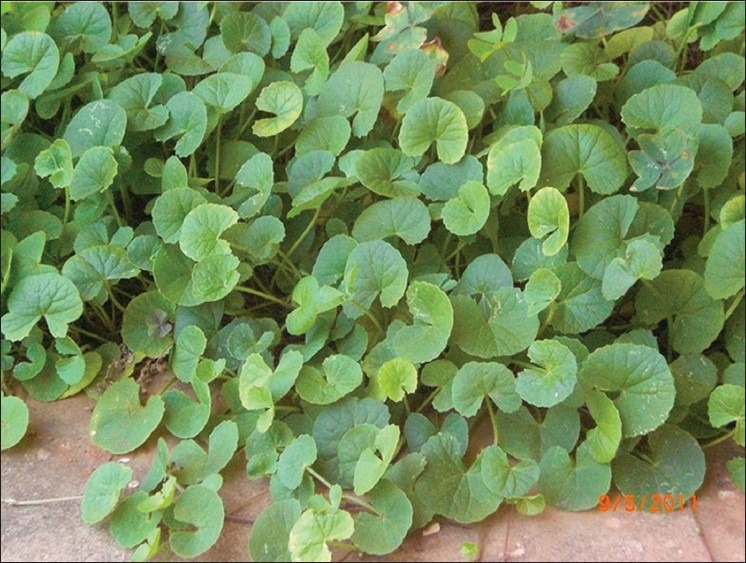
Centella asiatica
Yastimadhu (Glycirrhiza glabra Linn.) is a hardy herb or under shrub belonging to Fabaceae family[14] [Figure 2]. Fine powder of dried root is used internally with milk for therapeutic purpose as Medhya.[2] Active ingredients are glycyrrhizine, flavonones,[15] isoflavones, glycyrrhetenic acid,[16] six phenolic compounds.[17] Multidimensional activities of Yashtimadhu may be attributed to glycyrrhizine and flavonones. Yashtimadhu is cytotoxic and its prolonged use may lead to pseudoaldosteronism,[18] hyperkalemia,[19] and hypertension.[20,21] The roots and rhizomes of G. glabra has been studied with respect to spatial learning and passive avoidance[22] preliminary free radical scavenging[23] cerebral ischemia[24] and antioxidant capacity towards LDL oxidation.[25] Glycyrrhiza glabra aqueous extract markedly improves antihypoxic effects induced by sodium nitrite in rats and this effect may be mediated by its antioxidant properties.[26,27] The roots and rhizomes of Glycyrrhiza glabra is an efficient brain tonic; it increases the circulation into the CNS system and balance the sugar levels in the blood.[28] Liquorice has significant action on memory enhancing activity in dementia[29] it significantly improved learning and memory on scopolamine induced dementia.
Figure 2.
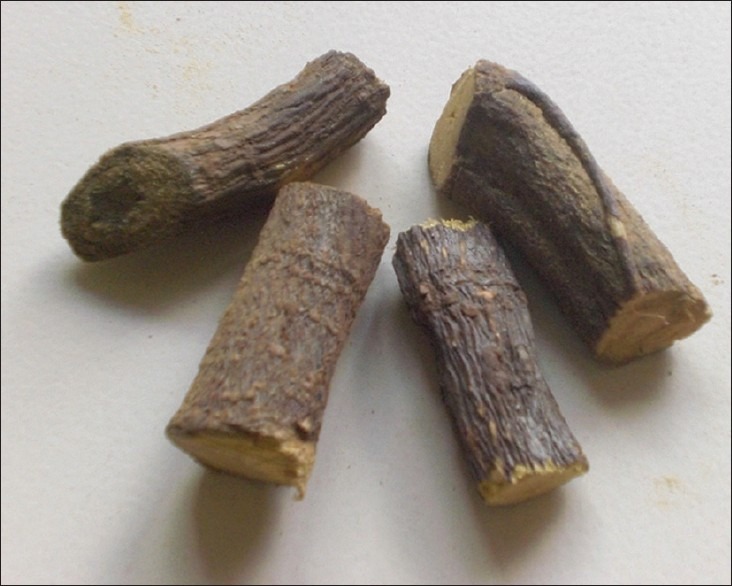
Glycirrhiza glabra
Guduchi (Tinospora cordifolia (Wild) Miers) is a large glabrous, deciduous, climbing shrub of Menispermaceae family found throughout tropical India[30] [Figure 3]. Juice of whole plant is used therapeutically as Medhya.[2] It is also used in the form of decoction, powder and Satwa (starch extract of stem). Its root is known for its anti stress, anti-leprotic and anti-malarial activities.[31,32] Chemical constituents’ classes are alkaloids, diterpenoid lactones, glycosides, steroids, sesquiterpenoid, phenolics, aliphatic compounds and polysaccharides.[33] Neuroprotective and ameliorative properties are due to their antioxidant and trace element contents.[34] Tinospora cordifolia is known to be a rich source of trace elements (Zinc and Copper) which act as antioxidants and protects cells from the damaging effects of oxygen radicals generated during immune activation.[35] It increases the blood profile and has lead scavenging activity.[36] Tinospora cordifolia has been claimed to possess learning and memory enhancing,[37] antioxidant,[38,39] and anti-stress activity.[40] Tinospora cordifolia enhanced the cognition in normal and cognition deficits animals in behavioural test Hebb William maze and the passive avoidance task.[41] Mechanism of cognitive enhancement is by immunostimulation and increasing the synthesis of acetylcholine, this supplementation of choline enhances the cognition.[42] Myriad actions of Guduchi may be attributed to its antioxidant[43,44] and immunomodulatory properties.[45]
Figure 3.
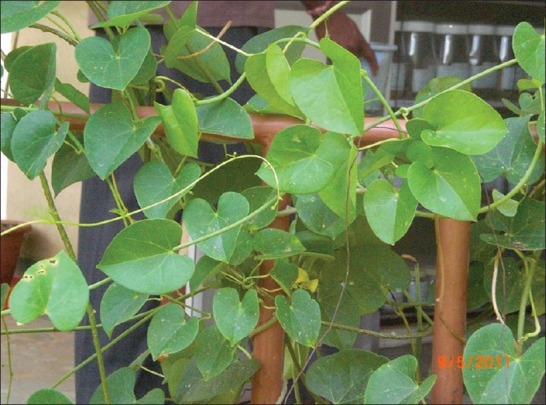
Tinospora cordifolia
Shankhapushpi (Convolvulus pleuricaulis Chois) is a perennial, prostate or sub erect spreading hairy herb,[46] found throughout India[47] [Figure 4]. Recommended therapeutic form is fine paste of whole plant. Highly regarded as Medhya (intellect promoter).[2] Important chemical principles are microphyllic acid, shankhapushpin, kaempferol-kaempferol-3-glucoside, 3, 4 dihydroxycinnamic acid, sitosterols. Neuroprotectve and intellect promoting activity implicated to free radical scavenging and antioxidant property.[48] BR-16A (Mentat), a poly herbal combination containing Shankhapushpi significantly reversed the social isolation stress-induced prolongation of onset and decrease in pentobarbitone-induced sleep, increased total motor activity and stress-induced antinociception in experimental model.[49] Ayushman-8 (containing Shankhpushpi, Brahmi and Vacha) reported to be effective on Manasa-mandata (mental retardation).[50] Shankhapushpi compound containing Shankhapushpi, Sarpagandha, and Gokshura in equal quanitities studied to be effective in Chittodvega (anxiety disorders).[51] Sanjay Parsania[52] reported Shankhapushpi to be effective in relieving signs and symptoms of Chittodvega (anxiety disorders). Herbalists believe that Shankhpushpi calms the nerves by regulating the body's production of the stress hormones, adrenaline and cortisol.[53] Few investigations reports that Shankhpushpi has potent depressive action in mice.[54] Convolvulus pleuricaulis whole plant extract, shows the highest inhibitory activity against Helicobacter muridarum.[55]
Figure 4.
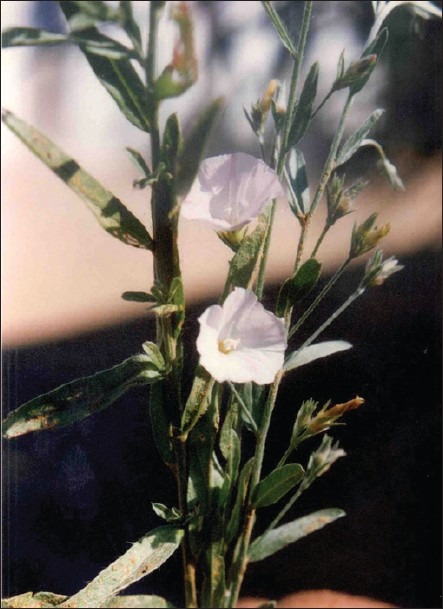
Convolvulus pluricaulis
Aindri (Bacopa monniera) commonly called as Brahmi belongs to Scrophulariaceae family.[56] It is a small, creeping marshy herb grown through out India[57] [Figure 5]. Most beneficial therapeutic form is macerated whole plant juice. Properties are said to be similar to that of Mandukaparni.[58] Bacopa monniera is a well-known nootropic plant reported for its tranquilizing,[59] sedative action,[60] cognitive enhancer,[61] hepatoprotective,[62] memory enhancer[63] and antioxidant actions.[64–66] Neuroprotective activity may be ascribed to having its reactive oxygen species scavenging property.[67] Bacopa monniera is a saponin rich plant.[68] Bacosides are the main active nootropic principle present in the alcoholic extract of the plant.[69]
Figure 5.
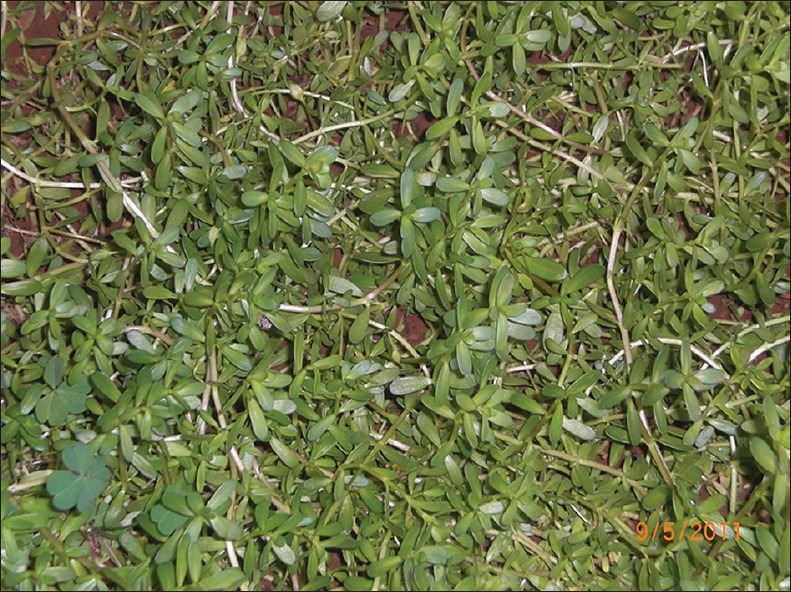
Bacopa monniera
Isolation of a new saponin, a jujubogenin, named bacopasaponin G, and a new glycoside, phenylethyl alcohol was reported.[70] Three new saponins designated as bacopasides III, IV and V isolated.[71] Apart from memory enhancer activity these bacosides have the potential to modulate the activities of heat stock protein (Hsp70) expression, cytochrome P450 and superoxide dismutase in the rat brain.[72] On rats, alcoholic extract increases both cognitive function and retention capacity, decreases retrograde amnesia and protects from phenytoin -induced cognitive deficit.[73] It is mainly utilized in the treatment of memory and attention disorders.[74]
Recent studies have indicated antioxidant effect of bacosides (triternoid saponin isolated from Bacopa monniera) against chronic toxin induced oxidative damage in rat brain[75] and thyroid T4 hormone stimulating activity in animals in high doses.[76]
Jyotishmati (Celastrus panniculata) is a large, woody, climbing shrub with ovate or obvovate leaves found all over India. Seeds are yellowish, ellipsoid or ovoid enclosed in a scarlet aril[77] [Figure 6], Seed oil (Jyotishmati Taila) is known for Medhya action.[78] This oil contains several terpenoids like paniculatadiol, b-sitosterol, celastrol, b-amyrin, pristimerin, but its most investigated components are its many sesquiterpenoids, dihydroagarofuran-type polyols or esters.[79] Celastrus paniculata showed antioxidant activity by decreasing the lipid peroxidation[80] and anti-arthritic activity in rat model.[81] Seed oil of Celastrus panniculata (Malkangni) reversed scopolamine-induced deficits in navigational memory task in young adult rats.[82]
Figure 6.
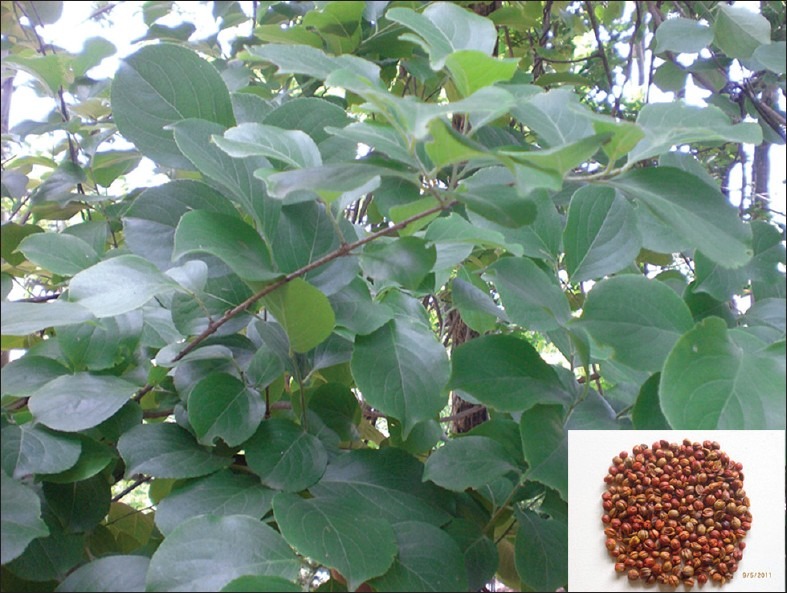
Celastrus panniculata
Kushmanda (Benincasa hispida) belonging to Cucurbitaceae an extensive trailing or climbing herb cultivated throughout the plains of India as a vegetable[83] [Figure 7]. The fruit, broadly cylindrical, is covered with a waxy bloom.[84] Phytochemical analysis of Benincasa hispida shows presence of alkaloids, flavinoids, saponins and steroids.[85] Benincasa cerifera serves as ROS scavenger and an antioxidant effective agent.[86] It has a tissue protective preventive effect on colchicine induced Alzheimer's disease via direct and indirect antioxidant activity.[87] Kushmandadi Ghrita showed significant results in the management Chittodvega (anxiety disorders).[88]
Figure 7.
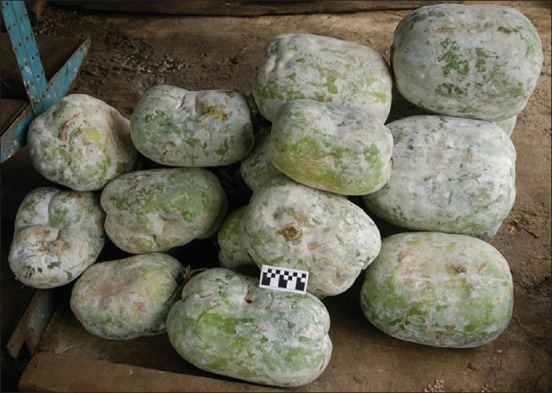
Benincasa hispida
Vacha (Acorus calamus) of Araceae family is a semiaquatic, perennial, aromatic herb with its rhizome being horizontal, rounded, somewhat vertically compressed, spongy and leaves grass like and sword shaped; grown all over India[89] [Figure 8]. Rhizome is useful part having Medhya quality. It has been used in Indian and Chinese system of medicine for hundreds of years to cure diseases especially the central nervous system (CNS) abnormalities.[90–93] Active chemical principles are α-asarone, elemicine, cis-isoelemicine, cis and trans isoeugenol and their methyl ethers, camphene, P-cymene, bgurjunene, a-selinene, b-cadinene, camphor,terpinen-4-ol, aterpineol and a-calacorene, acorone, acrenone, acoragermacrone, 2-deca–4,7 dienol, shyobunones, linalool and preisocalamendiol. Acoradin, galangin, 2, 4, 5- trimethoxy benzaldehyde, 2,5- dimethoxybenzoquinone, calamendiol,spathulenol and sitosterol are also present 2.[94,95]
Figure 8.
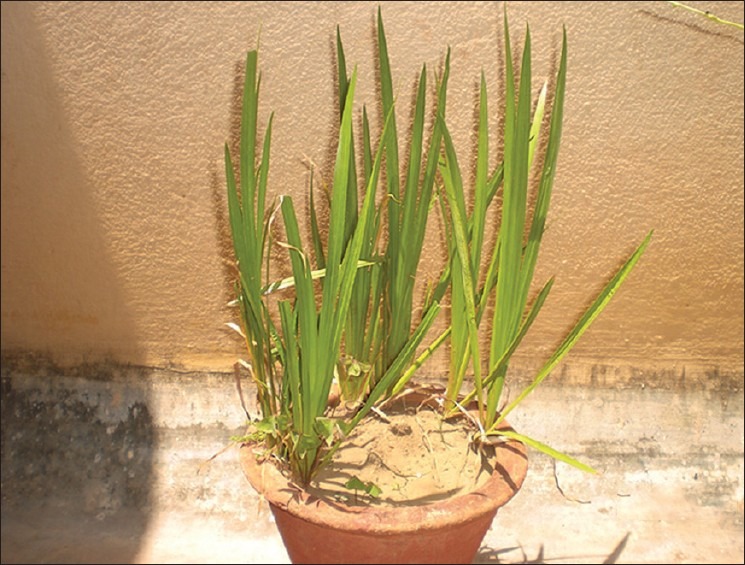
Acorus calamus
It has been proved for its analgesic and anticonvulsant,[96] hepatoprotective,[97] antioxidant,[98,99] antimutagenic,[100] sedative and hypothermic effects.[101] Good in clearing speech to the children[102,103] and useful in schizophrenic psycosis.[104]
Food and Drug Administration banned usage its oil in food formulations and in other therapeutic preparations[105] due carcinogenic and toxic properties of β-asarone compound.[106]
Jatamamsi (Nardostachys jatamamsi) is an erect perennial aromatic herb with long, stout, woody, greyish, rhizomatous, tail-like rootstock covered with reddish-brown hairs or tufted fibrous remains of the petioles of withered radical leaves[107] [Figure 9], and belongs to Valerianaceae family. Rhizome is used for medicinal purposes as it is Bhutaghna or Manasa Doshahara (relieves of psychiatric problems) and Medhya.[108] Roots and rhizomes of N. jatamansi are used to treat hysteria, epilepsy, and convulsions.[109] The decoction of the drug is also used in neurological disorders, insomnia and disorders of cardiovascular system.[110] Rhizomes contain a terpenoid ester, nardostachysin I.[111] It is proven to improve learning and memory in mice[112] and also to enhance biogenic amine activity.[113] An acetone extract of N. jatamansi has shown significant inhibition of benzoyl peroxide-induced cutaneous oxidative stress, toxicity, and ear oedema in mice.[114]
Figure 9.
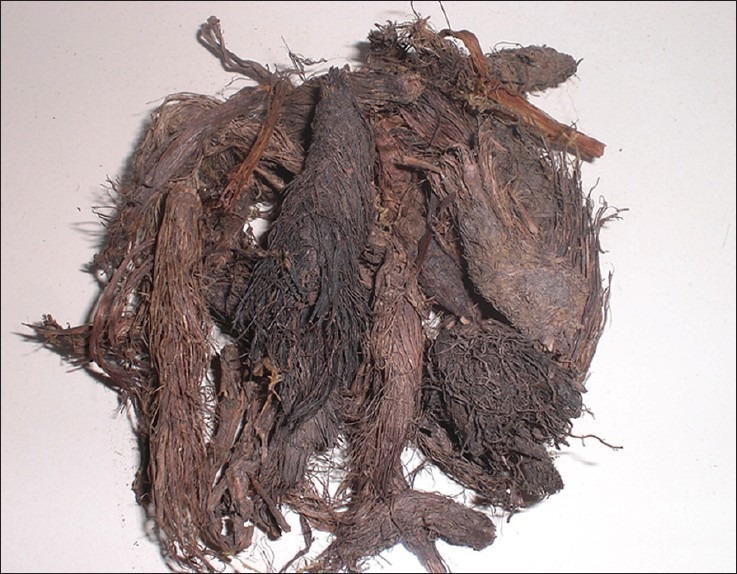
Nardostachys jatamamsi
DISCUSSION AND CONCLUSION
Data available so far support procognitive activity of herbs selected for discussion; at the same time demand substantial evidences and revalidation in humans. Mostly the above said herbs act on the basis of antioxidant, adaptogenic or essential trace elements present in them. Their activity on modulation of biological axis and neurotransmitters requires further investigation.
ACKNOWLEDGMENT
Authors acknowledge support from Dr Prasanna N Rao and Dr Shailaja U for guidance during preparation of article.
Footnotes
Source of Support: Nil
Conflict of Interest: None declared.
REFERENCES
- 1.Sharma PC, Yelne MB, Dennis TJ. Database on Medicinal plants used in Ayurveda and Sidha. Vol. 1. New Delhi: CCRAS, Dept. of AYUSH, Ministry of Health and Family Welfare, Govt. of India; 2000. pp. 264–79. [Google Scholar]
- 2.Acharya YT, editor. Caraka Samhita with Chakrapani's Ayurveda Deepika Teeka. Varanasi: Choukhamba Samskrita Samsthana; 1994. Agnivesha; p. 385. [Google Scholar]
- 3.Sharma PC, Yelne MB, Dennis TJ. Database on Medicinal plants used in Ayurveda and Sidha. Vol. 1. New Delhi: CCRAS, Dept. of AYUSH, Ministry of Health and Family Welfare, Govt. of India; 2005. pp. 265–6. [Google Scholar]
- 4.Ramanathan M, Sivakumar S, Anand Vijayakumar PR, Saravanababu C, Rathinavel Pandian P. Neuroprotective evaluation of standardized extracts of Centella asiatica in monosodium glutamate treated rats. Indian J Exp Biol. 2007;45:425–31. [PubMed] [Google Scholar]
- 5.Anbuganapathi GA. Synergetic effect of Vallarai and Brahmi on learning ability of albino mice and school children. Ootacamund: Paper presented at the International Seminar on Recent Trends in Pharmaceutical Sciences; 1995. pp. 18–20. [Google Scholar]
- 6.Mohandas Rao KG, Muddanna Rao S, Gurumadhva Rao S. Centella asiatica (L.) Leaf Extract Treatment during the Growth Spurt Period Enhances Hippocampal CA3 Neuronal Dendritic Arborization in Rats. eCAM. 2006;3:349–57. doi: 10.1093/ecam/nel024. [DOI] [PMC free article] [PubMed] [Google Scholar]
- 7.Visweswari G, Sivaprasad K, Lokanatha V, Rajendra W. The antiepileptic effect of Centella asiatica on the activities of Na + /K +, Mg 2+ and Ca 2+ -ATPases in rat brain during pentylenetetrazol-induced epilepsy. Indian J Pharmacol. 2010;42:82–6. doi: 10.4103/0253-7613.64504. [DOI] [PMC free article] [PubMed] [Google Scholar]
- 8.Russo A, Borrelli F. Bacopa monniera, a reputed nootropic plant: An overview. Phytomed. 2005;12:305–17. doi: 10.1016/j.phymed.2003.12.008. [DOI] [PubMed] [Google Scholar]
- 9.Kumar A, Kulkarni SK. Protective effect of BR-16A, a polyherbal preparation against social isolation stress: Possible GABAergic mechanism. Phytother Res. 2006;20:538–41. doi: 10.1002/ptr.1873. [DOI] [PubMed] [Google Scholar]
- 10.Anand T, Naika M, Kumar PG, Khanum F. Antioxidant and DNA Damage Preventive Properties of Centella asiatica (L) Urb. Phcog J. 2010;2:53–8. [Google Scholar]
- 11.Ashawat MS, Saraf S, Saraf S. Preparation and Characterization of herbal creams for improvement of skin viscoelastic properties. Int J Cosmet Sci. 2008;30:183–93. doi: 10.1111/j.1468-2494.2008.00442.x. [DOI] [PubMed] [Google Scholar]
- 12.Devi UK, Swarup A. Evaluation of Clinical Efficacy of Menotab in Alleviating Symptoms of Menopausal Syndrome: Phase III Open Clinical Trial. Antiseptic. 2001;98:87–9. [Google Scholar]
- 13.Oruganti M, Roy B, Singh K, Prasad R, Kumar S. Safety Assemment of Centella asiatica in albino rats. Phcog J. 2010;2:5–11. [Google Scholar]
- 14.Sharma PC, Yelne MB, Dennis TJ. Database on Medicinal plants used in Ayurveda and Sidha. Vol. 3. New Delhi: CCRAS, Dept. of AYUSH, Ministry of Health and Family Welfare, Govt. of India; 2005. pp. 561–617. [Google Scholar]
- 15.Hatano T, Shintani Y, Shiota S, Tsuchiya T, Yoshida T. Phenolic constituents of licorice. VIII. Structures of glicophenone and glycoisofl avanonem and effects of licorice, phenolics on Methicillin- resistant Staphylococcus aureus. Chem Pharm Bull. 2000;48:1286–92. doi: 10.1248/cpb.48.1286. [DOI] [PubMed] [Google Scholar]
- 16.Ishii Y, Fuji Y. Effects of FM 100, a fraction of licorice root on serum gastrin concentration in rats and dogs. Jpn J Pharmacol. 1982;32:23–7. doi: 10.1254/jjp.32.23. [DOI] [PubMed] [Google Scholar]
- 17.Kuroda M, Mimaki Y, Sashida Y, Mae T, Kishida H, Nishiyama H, et al. Phenolics with PPAR- Ligand binding activity obtaind from Licorice (Glycyrrhiza uralensis roots) and ameliorative effects of Glycyrin on genetically diabetic KK-Ay mice. Bioorg Med Chem Lett. 2004;13:4267–72. doi: 10.1016/j.bmcl.2003.09.052. [DOI] [PubMed] [Google Scholar]
- 18.Kanda H, Sakurai M, Arima K. Licorice of “Shukuyaku Kanzou tou” induced pseudoaldosteronism. Hinyokika Kiyo. 2004;50:215–7. [PubMed] [Google Scholar]
- 19.Yoshida S, Takayama Y. Licorice induced hyperkalemia as a treatable cause of dropped head syndrome. Clin Neurol Neurosurg. 2003;105:286–7. doi: 10.1016/s0303-8467(03)00042-8. [DOI] [PubMed] [Google Scholar]
- 20.Sigurjonsdottir HA, Franzson L, Manhem K, Ragnarsson J, Sigurdsson G, Wallerstedt S. Licorice induced rise in Blood pressure, a linear dose response relationship. J Hum Hypertens. 2001;15:549–52. doi: 10.1038/sj.jhh.1001215. [DOI] [PubMed] [Google Scholar]
- 21.Nussberger J. Investigating mineralocorticoids hypertension. J Hypertension. 2003;2(Suppl):525–30. [Google Scholar]
- 22.Ravichandra V, Ahalyadevi, Adiga S. Evaluation of the effect of Glycyrrhiza glabra Linn. root extract on spatial learning and passive avoidance response in rats. Indian Drugs. 2007;44:214–9. [Google Scholar]
- 23.Toshio F, Kazue S, Taro N. Preliminary evaluation of anti nephritis and radical scavenging activities of glabridin from Glycyrrhiza glabra Linn. Fitotherapia. 2003;74:624–9. doi: 10.1016/s0367-326x(03)00164-3. [DOI] [PubMed] [Google Scholar]
- 24.Zhan C, Yang J. Protective effects of isoliquiritigenin in transient middle cerebral artery occlusion induced focal cerebral ischemia in rats. Pharmacol Res. 2006;53:303–9. doi: 10.1016/j.phrs.2005.12.008. [DOI] [PubMed] [Google Scholar]
- 25.Vaya J, Belinky PA, Aviram M. Structural aspects of the inhibitory effect of glabridin on LDL oxidation. Free Rad Biol Med. 1998;24:1419–29. doi: 10.1016/s0891-5849(98)00006-9. [DOI] [PubMed] [Google Scholar]
- 26.Muralidharan P, Balamurugan G, Venu Babu. Cerebroprotective effect of Glycyrrhiza glabra Linn. root extract on Hypoxic rats. Bangladesh J Pharmacol. 2009;4:60–4. [Google Scholar]
- 27.Devasagayam TP, Tilak JC, Boloor KK, Sane KS, Ghaskadbi SS, Lele RD. Free radicals and antioxidants in Human Health: Current status and future prospects. J Assoc Physicians India. 2004;52:794–803. [PubMed] [Google Scholar]
- 28.Rathee P, Chaudhary H, Rathee S, Rathee D. Natural memory boosters. Phcog Rev. 2008;2:249–56. [Google Scholar]
- 29.Dhingra D, Parle M, Kulkarni SK. Memory enhancing activity of Glycyrrhiza Glabra in mice. J Ethnopharmacol. 2004;91:361–5. doi: 10.1016/j.jep.2004.01.016. [DOI] [PubMed] [Google Scholar]
- 30.Sharma PC, Yelne MB, Dennis TJ. Database on Medicinal plants used in Ayurveda and Sidha. Vol. 3. New Delhi: CCRAS, Dept. of AYUSH, Ministry of Health and Family Welfare, Govt. of India; 2005. pp. 256–81. [Google Scholar]
- 31.Nayampalli S, Ainapure SS, Nadkarni PM. Study of antiallergic acid Bronchodilator effects of Tinospora cordifolia. Indian J Pharm. 1982;14:64–6. [Google Scholar]
- 32.Zhao TF, Wang X, Rimando AM, Che C. Folkloric medicinal plant: Tinospora sagittata var.cravaniana and Mohonia bealei. Planta Med. 1991;57:505–3. doi: 10.1055/s-2006-960188. [DOI] [PubMed] [Google Scholar]
- 33.Singh SS, Pandey SC, Srivastava S, Gupta VS, Patro B, Ghosh AC. Chemistry and Medicinal properties of Tinospora cordifolia (Guduchi) Indian J Pharmacol. 2003;35:83–91. [Google Scholar]
- 34.Avinash KR, Manohar GM, Saibal KB. Rubia cordifolia, Fagonia cretica Linn.and Tinospora cordifolia exert neuroprotection by modulating the antioxidant system in rat hippocampal slices subjected to oxygen glucose deprivation. BMC Complement Altern Med. 2004;4:11. doi: 10.1186/1472-6882-4-11. [DOI] [PMC free article] [PubMed] [Google Scholar]
- 35.Chulet R, Pradhan P. A review on Rasayana. Phcog Rev. 2009;3:229–34. [Google Scholar]
- 36.Sharma V, Pandey D. Protective role of Tinospora cordifolia against lead-induced hepatotoxicity. Toxicol Int. 2010;17:12–7. doi: 10.4103/0971-6580.68343. [DOI] [PMC free article] [PubMed] [Google Scholar]
- 37.Agarwal A, Malini S, Bairy KL, Rao MS. Effect of Tinospora cordifolia on Learning and Memory in normal and memory deficit rats. Indian J Pharmacol. 2002;34:339–49. [Google Scholar]
- 38.Singh RP, Banergee S, Kumar PV, Raveesha KA, Rao AR. Tinospora cordifolia induces enzymes of carcinogen/ drug metabolism and antioxidant System, and inhibits lipid peroxidation in mice. Phytomedicine. 2006;13:74–84. doi: 10.1016/j.phymed.2004.02.013. [DOI] [PubMed] [Google Scholar]
- 39.Stanely M, Prince P, Menon VP. Antioxidant action of Tinospora cordifolia root extract in alloxan diabetic rats. Phytother Res. 2001;15:213–8. doi: 10.1002/ptr.707. [DOI] [PubMed] [Google Scholar]
- 40.Patil M, Patki P, Kamath HV, Patwardhan B. Antistress activity of Tinospora cordifolia (Willd) Meirs. Indian drugs. 1997;34:211–5. [Google Scholar]
- 41.Yalla Reddy Y, Mohana Lakshmi S, Saravana KA. Review on Effect of Natural Memory Enhancing Drugs On Dementia. Int J Phytopharmacol. 2010;1:1–7. [Google Scholar]
- 42.Asuthosh A, Malini S, Bairy KL, Muddanna SR. Effect of Tinospora cordifolia on learning and memory in normal and memory deficits rats. Indian J Pharmacol. 2000;34:339–49. [Google Scholar]
- 43.Prince PS, Kamalakkannan N, Menon VP. Restoration of antioxidant defence by ethanolic Tinospora cordifolia root extract in alloxan-induced diabetic liver and kidney. Phytother Res. 2004;18:785–7. doi: 10.1002/ptr.1567. [DOI] [PubMed] [Google Scholar]
- 44.Devasagayam TP, Tilak JC, Boloor KK, Sane KS, Ghaskadbi SS, Lele RD. Free radicals and antioxidants in Human Health: Current status and future prospects. J Assoc Physicians India. 2004;52:794–803. [PubMed] [Google Scholar]
- 45.Manjrekar PN, Jolly CI, Narayanan S. Comparative studies of the immunomodulatory activity of Tinospora cordifolia and Tinospora sinensis. Fitoterapia. 2000;71:254–7. doi: 10.1016/s0367-326x(99)00167-7. [DOI] [PubMed] [Google Scholar]
- 46.Billore KV, Yelne MB, Dennis TJ, Chaudhari BG. In: Database on Medicinal plants used in Ayurveda and Sidha. Joshi A, Prabhune YS, editors. Vol. 7. New Delhi: CCRAS, Dept. of AYUSH, Ministry of Health and Family Welfare, Govt. of India; 2005. pp. 433–41. [Google Scholar]
- 47.Part 1. Vol. 2. Delhi: Controller of Publications, Civil Lines; 1999. The Ayurvedic Pharmacopoeia of India; p. 155. [Google Scholar]
- 48.Bhatnagar M, Sisodia SS, Bhatnagar R. Antiulcer and antioxidant activity of Asparagus racemosus Willd and Withania somnifera Dunal in rats. Ann NY Acad Sci. 2005;1056:261–78. doi: 10.1196/annals.1352.027. [DOI] [PubMed] [Google Scholar]
- 49.Kumar A, Kulkarni SK. Protective effect of BR-16A, a polyherbal preparation against social isolation stress: Possible GABAergic mechanism. Phytother Res. 2006;20:538–41. doi: 10.1002/ptr.1873. [DOI] [PubMed] [Google Scholar]
- 50.Rajagopalan V. Seminar on research in Ayurveda and Sidha. New Delhi: CCRAS; 1995. [Google Scholar]
- 51.Kalra Sanjeev. A study on the effect of Shankhapushpi compound and Satwavajaya Chikitsa in Chittodvega (generalized anxiety disorders) Dept. of Post Graduate studies in Manasa Roga, SDM College of Ayurveda and Hospital. Hassan, Rajiv Gandhi University of Health Sciences, Karnataka. 2006 [Google Scholar]
- 52.Parsania S. A clinical study on the role of Jaladhara and Shankhapushpi (Convolvulus pleuricaulis) in the management of Chittodvega (anxiety disorder) Jamnagar: Dept. of Kayachikitsa, IPGT and RA, Gujarat Ayurveda university; 2001. [Google Scholar]
- 53.Kumar V. Potential Medicinal Plants for CNS Disorders: An Overview. Phytother Res. 2006;20:1023–35. doi: 10.1002/ptr.1970. [DOI] [PubMed] [Google Scholar]
- 54.Indurwade NH, Biyani KR. Evaluation of comparative and combined depressive effect of Brahmi, Shankhpushpi and Jatamansi in mice. Indian J Med Sci. 2000;54:339–41. [PubMed] [Google Scholar]
- 55.Vimal SK, Sharma D, Bhatnagar M. Anti-bacterial activity of herbal extracts, EuMiL® and antibiotics against Helicobacter muridarum. Pharmacogn J. 2010;2:436–41. [Google Scholar]
- 56.Sharma PV. Dravyaguna Vijnana. Vol. 2. Varanasi: Chaukhambha Bharati Academ; 1995. pp. 6–8. (in Hindi) [Google Scholar]
- 57.Sharma PC, Yelne MB, Dennis TJ. Database on Medicinal plants used in Ayurveda and Sidha. Vol. 1. New Delhi: CCRAS, Dept. of AYUSH, Ministry of Health and Family Welfare, Govt. of India; 2000. pp. 93–101. [Google Scholar]
- 58.Bhavaprakasha Nighantu. 1st ed. Varanasi: Chaukhamba Publishers; 2007. Bhavaprakasha; p. 131. [Google Scholar]
- 59.Aithal HN, Sirsi M. Pharmacological investigation of Herpestis monneri. Indian J Pharmcol. 1961;23:2–5. [Google Scholar]
- 60.Malhotra CL, Das PK. Pharmacological studies of Herpestis monneri. Indian J Med Res. 1959;47:244–305. [PubMed] [Google Scholar]
- 61.Singh HK, Dhawan BN. Neuropsychopharmacological effects of the Ayurvedic Nootropic Bacopa monneri Linn.(Bramhi) Indian J Pharmacol. 1997;29:359–65. [Google Scholar]
- 62.Sumathy T, Subramanian S, Govindaswamy S, Balakrishna K, Veluchamy G. Protective role of Bacopa monniera on morphine-induced hepatotoxicity in rats. Phytother Res. 2001;15:643–5. doi: 10.1002/ptr.1007. [DOI] [PubMed] [Google Scholar]
- 63.Raghav S, Singh H, Dalal PK, Srivastava JS, Asthana OP. Randomized controlled trial of Bacopa monniera extract in age- associated memory impairment. Indian J Psychiatry. 2006;48:238–42. doi: 10.4103/0019-5545.31555. [DOI] [PMC free article] [PubMed] [Google Scholar]
- 64.Tripathi YB, Chaurasia S, Tripathi E, Upadhyay A, Dubey GP. Bacopa monniera Linn. as an antioxidant: Mechanism of action. Indian J Exp Biol. 1996;34:523–6. [PubMed] [Google Scholar]
- 65.Devasagayam TP, Tilak JC, Boloor KK, Sane KS, Ghaskadbi SS, Lele RD. Free radicals and antioxidants in Human Health: Current status and future prospects. J Assoc Physicians India. 2004;52:794–803. [PubMed] [Google Scholar]
- 66.Bhattacharya SK, Bhattacharya A, Kumar A, Ghosal S. Antioxidant activity of Bacopa monniera in rat frontal cortex, striatum and hippocampus. Phytother Res. 2000;14:174–9. doi: 10.1002/(sici)1099-1573(200005)14:3<174::aid-ptr624>3.0.co;2-o. [DOI] [PubMed] [Google Scholar]
- 67.Rehni AK, Pantlya HS, Shri R, Singh M. Effect of Chlorophyll and aqueous extracts of Bacopa monniera and Valeriana wallichii on ischemia and reperfusion induced cerebral injury in mice. Indian J Exp Biol. 2007;45:764–9. [PubMed] [Google Scholar]
- 68.Maciuk A, Bouchet MJ, Mazars G, Um BH, Anton R. Nootropic (Medhya) plants from ayurvedic pharmacopeia. Etudes chimiques et pharmacologiques. 2002:402–11. [Google Scholar]
- 69.Girish SA, Barabde U, Wadodkar S, Dorle A. Effect of Bramhi Ghrita, an polyherbal formulation on learning and memory paradigms in experimental animals. Indian J Pharmacol. 2004;36:159–62. [Google Scholar]
- 70.Hou CC, Lin SJ, Cheng JT, Hsu FL. Bacopasaponin G and bacopasides A, B, and C from Bacopa monniera. J Nat Prod. 2002;65:1759–63. doi: 10.1021/np020238w. [DOI] [PubMed] [Google Scholar]
- 71.Chakravarty AK, Garai S, Masuda K, Nakane T, Kawahara N. Bacopasides III-V: Three new triterpenoid glycosides from Bacopa monniera. Chem Pharm Bull. 2003;51:215–7. doi: 10.1248/cpb.51.215. [DOI] [PubMed] [Google Scholar]
- 72.Choudhari DK, Parmar D, Kakkar P, Shukla R, Seth PK, Srimal RC. Antistress effects of bacosides of Bacopa monneri: Modulation of Hsp70 expression, superoxide dismutase and cytochrome P450 activity in rat brain. Phytother Res. 2002;16:639–45. doi: 10.1002/ptr.1023. [DOI] [PubMed] [Google Scholar]
- 73.Vohora D, Pal SN, Pillai KK. Protection from phenytoin induced cognitive deficits by Bacopa monnieri, a reputed Indian nootropic plant. J Ethnopharmacol. 2000;71:383–90. doi: 10.1016/s0378-8741(99)00213-5. [DOI] [PubMed] [Google Scholar]
- 74.Shukla B, Khanna NK, Godhwani L. Effect of Brahmi Rasayan on the central nervous system. J Ethnopharmacol. 1987;21:65–74. doi: 10.1016/0378-8741(87)90095-x. [DOI] [PubMed] [Google Scholar]
- 75.Anbarasi K, Vani G, Balakrishna K, Devi CS. Effect of Bacoside A on Brain antioxidant status in cigarette smoke exposed rats. Life Sci. 2006;78:1378. doi: 10.1016/j.lfs.2005.07.030. [DOI] [PubMed] [Google Scholar]
- 76.Kar A, Panda S, Bharati S. Relative efficacy of three medicinal plant extracts in the alteration of thyroid hormone concentrations in male mice. J Ethnopharmacol. 2002;81:281–5. doi: 10.1016/s0378-8741(02)00048-x. [DOI] [PubMed] [Google Scholar]
- 77.Sharma PC, Yelne MB, Dennis TJ. Database on Medicinal plants used in Ayurveda and Sidha. Vol. 2. New Delhi: CCRAS Dept. of AYUSH, Ministry of Health and Family Welfare, Govt. of India; 2005. pp. 281–91. [Google Scholar]
- 78.Bhavaprakasha Nighantu. 1st ed. Varanasi: Chaukamba Publishers; 2007. Bhavamishra; p. 32. [Google Scholar]
- 79.Yong QT, Yao ZC, Da GW, Xian MZ, Xiao JH. Sesquiterpenoids from Celastrus paniculatus. J Nat Prod. 1993;56:122–5. [Google Scholar]
- 80.Kumar MH, Gupta YK. Antioxidant property of Celastrus paniculatus Willd.A possible mechanism in enhancing cognition. Phytomedicine. 2002;9:302–11. doi: 10.1078/0944-7113-00136. [DOI] [PubMed] [Google Scholar]
- 81.Kalpana SP, Jayaprakash Effect of Celastrus paniculatus Willd.Seed on adjuvant induced arthritis. Phcog Mag. 2007;3:11. [Google Scholar]
- 82.Gattu M, Boss KL, Terry AV, Buccafusco JL. Reversal of scopolamine induced deficits in navigational memory performance by the seed oil of Celastrus paniculatis. Pharmacol Biochem Behav. 1995;57:793–9. doi: 10.1016/s0091-3057(96)00391-7. [DOI] [PubMed] [Google Scholar]
- 83.Part 1. Vol. 4. Delhi: Controller of Publications; 2004. The Ayurvedic Pharmacopoeia of India; pp. 62–3. [Google Scholar]
- 84.Sharma PV. Dravyaguna-vijnana. Vol. 2. Varanasi: Chaukhambha Bharati Academy; 1995. pp. 4–17. in Hindi. [Google Scholar]
- 85.Battu GR, Mamidipalli SN, Parimi R, Viriyala RK, Patchula RP, Mood LR. Hypoglycemic and anti-hyperglycemic effect of alclholic extract of Benincasa hispida in normal and in alloxan induced diabetic rats. Phcog Mag. 2007;3:10. [Google Scholar]
- 86.Bhalodia YS, Patel NJ, Patel RK, Vaghasiya JD, Jivani NP, Sheth NR. Benincasa cerifera ameliorates Renal ischemia/Reperfusion injury in hyperlipidemic rat. Phcog Res. 2009;1:406–9. [Google Scholar]
- 87.Lim SJ. Effects of fractions of Benincasa hispida on antioxidant status in Streptozotocin induced Diabetic rats. Korean J Nutr. 2007;40:295–302. [Google Scholar]
- 88.Ahir YU. Clinico-experimental study of Kushmandadi Ghrita in Generalized Anxiety Disorder(DSM-IV) w.s.r.to Chittodvega. Jamnagar: Dept. of Kayachikitsa, IPGT and RA, Gujarat Ayurveda University; 2005. [Google Scholar]
- 89.Sharma PC, Yelne MB, Dennis TJ. Database on Medicinal plants used in Ayurveda and Sidha. Vol. 1. New Delhi: CCRAS, Dept. of AYUSH, Ministry of Health and Family Welfare, Govt. of India; 2000. pp. 469–95. [Google Scholar]
- 90.Lai XY, Liang H, Zhao YY. A survey of the studies on chemical constituents and pharmacological activities of Acorus plants. Zhongguo Zhong Yao Za Zhi. 2002;27:161–5. 198. [PubMed] [Google Scholar]
- 91.Shukla PK, Khanna V, Ali M, Maurya R, Khan MY, Srimal RC. Neuroprotective effect of Acorus calamus against middle cerebral artery occlusion-induced ischaemia in rat. Hum Exp Toxicol. 2006;5:187–94. doi: 10.1191/0960327106ht613oa. [DOI] [PubMed] [Google Scholar]
- 92.Koo BS, Park KS, Ha JH, Park JH, Lim JC, Lee DU. Inhibitory effects of the fragrance inhalation of essential oil from Acorus gramineus on central nervous system. Biol Pharm Bull. 2003;26:978–82. doi: 10.1248/bpb.26.978. [DOI] [PubMed] [Google Scholar]
- 93.Mukherjee PK, Kumar V, Mal M, Houghton PJ. In vitro cetylcholinesterase inhibitory activity of the essential oil from Acorus calamus and its main constituents. Planta Med. 2007;73:283–5. doi: 10.1055/s-2007-967114. [DOI] [PubMed] [Google Scholar]
- 94.Mazza G. Gas chromatographic and mass spectrometry studies of the constituents of the rhizome of Acorus calamus II, The volatile constituents of essential oil. J Chromatogr. 1985;328:179. [Google Scholar]
- 95.Willamson EM, Evans FJ. Potter's new cyclopedia of botanical drugs and preparations. Walden, Essex: Saffron Walden; 1988. [Google Scholar]
- 96.Jayaraman R, Anitha T, Vishal DJ. Analgesic and Anticonvulsant effects of Acorus calamus roots in mice. Int J Pharm Tech Res. 2010;2:552–5. [Google Scholar]
- 97.Palani S, Raja S, Praveen KR, Venkadesan D, Devi K, Sivaraj A, et al. Therapeutic efficacy of antihepatotoxic and antioxidant activities of Acorus calamus on acetaminophen- induced toxicity in rats. Int Journal Integr Biol. 2009;7:39–44. [Google Scholar]
- 98.Acuna UM, Atha DE, Ma J, Nee MN, Kennelly EJ. Antioxidant capacities of ten edible North American plants. Phytother Res. 2002;16:63–5. doi: 10.1002/ptr.1031. [DOI] [PubMed] [Google Scholar]
- 99.Shahin SA, Naresh K, Abhinav L, Angad S, Hallihosur S, Abhishek S, et al. Review Indian medicinal herbs as sources of antioxidants. Food Res Int. 2008;41:1–15. [Google Scholar]
- 100.Aqil F, Zahin M, Ahmad I. Antimutagenic activity of methanolic extracts of four ayurvedic medicinal plants. Indian J Exp Biol. 2008;46:668–72. [PubMed] [Google Scholar]
- 101.Zanoli P, Avallone R, Baraldi M. Sedative and hypothermic effects induced by â-asarone, a main component of Acorus calamus. Phytother Res. 1998;12:S114–6. [Google Scholar]
- 102.Ignacimuthu S, Ayyanar M, Sivaraman S. Ethnobotanical investigations among tribes in Madurai District of Tamil Nadu (India) J Ethnobiol Ethnomed. 2006;2:25. doi: 10.1186/1746-4269-2-25. [DOI] [PMC free article] [PubMed] [Google Scholar]
- 103.Chellaiah M, Muniappan A, Nagappan R, Savarimuthu I. Medicinal plants used by traditional healers in Kancheepuram District of Tamil Nadu, India. J Ethnobiol Ethnomed. 2006;2:43. doi: 10.1186/1746-4269-2-43. [DOI] [PMC free article] [PubMed] [Google Scholar]
- 104.Fozdar NG, Doongaji, Bauadia VN, Vahia NS. Preliminary of report an indegenious drug Acorus calamus in psychiatric disorders. Indian J Psychiatry. 1962;4:1. [Google Scholar]
- 105.Ravindran PN, Balachandran I. Under utilized medicinal spices. Spice India. 2004;17:2–14. [Google Scholar]
- 106.Riaz M, Chaudhary FM. Chemistry of medicinal plants of genus acorus (family Aracae) Hamdard Medicus. 1995;38:50–62. [Google Scholar]
- 107.Bellore KV, Yelne MB, Dennis TJ, Chaudhari BG. Database on Medicinal plants used in Ayurveda and Sidha. Vol. 7. New Delhi: CCRAS, Dept. of AYUSH, Ministry of Health and Family Welfare, Govt. of India; 2005. pp. 135–57. [Google Scholar]
- 108.Bhavaprakasha Nighantu. 1st ed. Varanasi: Chaukamba Publishers; 2007. Bhavaprakasha; p. 65. [Google Scholar]
- 109.Bagchi A, Oshima Y, Hikino H. Neoligans and lignans of Nardostachys Jatamansi Roots. Planta Med. 1991;57:96–7. doi: 10.1055/s-2006-960037. [DOI] [PubMed] [Google Scholar]
- 110.Uniyal MR, Issar RK. Commercially and traditionally important medicinal plants of Mandakini valley of Uttarkhand Himalayas. J Res Indian Med. 1969;4:83–96. [Google Scholar]
- 111.Chatterjee A, Basak B, Saha M, Dutta U, Mukhopadhyay C, Banerji J, et al. Structure and Stereo-chemistry of Nardostachysin, A New Terpenoid ester constituent of the Rhizomes of Nardostachys Jatamansi. J Nat Prod. 2000;63:1531–3. doi: 10.1021/np990503m. [DOI] [PubMed] [Google Scholar]
- 112.Joshi H, Parle M. Nardostachys jatamansi improves learning and memory in mice. J Med Food. 2006;9:113–8. doi: 10.1089/jmf.2006.9.113. [DOI] [PubMed] [Google Scholar]
- 113.Ahamad M, Saleem S, Ahamad AS, Ansari MA, Yousuf S, Hoda MN, et al. Neuroprotective effect of Withania sominifera on 6-hydroxydopamine induced Parkinsonism in rats. Hum Exp Toxicol. 2005;24:137–47. doi: 10.1191/0960327105ht509oa. [DOI] [PubMed] [Google Scholar]
- 114.Ali A, Dua Y, Siddiqui AW, Sultana S, Rafiullah MR. Inhibition of benzoyl peroxide-induced cutaneous oxidative stress, toxicity and ear edema in mice by Nardostachys Jatamansi. Pharm Biol. 2005;43:533–9. [Google Scholar]


